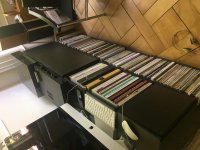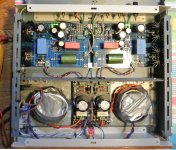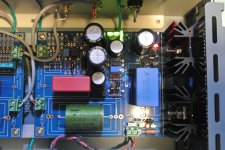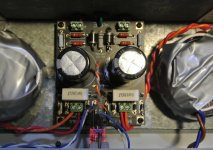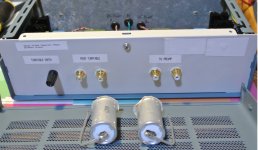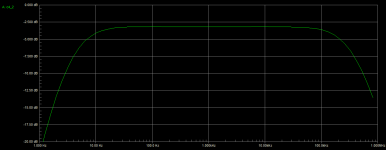A few photos of my second build of this magic design. Had quite a time of this build and needed to look very carefully at Salas's advice to other builders to get to grips with difficulties in getting the voltages in the ballpark to set the bias to 3.60V in each channel. Couldn't have done it without you Salas. Your sage advice to elwood set me on the right path.
I think one cause for me was an external one: our notional mains supply of 230V spends most of its time very close to 250V so the raw supply was over 53V in each channel. After addressing that problem with the addition of 18R 5W in place of the links in the raw supply, I then needed to adjust R3x in each channel to bring the voltages within the range of the trimmers, ending with about 34V in each channel to give the required 3.60V between TP1 and TP2.
Had another interesting experience with C3. Initially fitted a couple of very large Russian .1uF caps but they had the unfortunate ability to act as antennas for every 50Hz signal within cooee. Fortunately I had in my collection a couple of Wima FKP1 .047uF and they solved the problem perfectly.
You will note that I have built the power supply in the same enclosure, ensuring that it is shielded from the main boards by a steel plate effectively having the PS in a Faraday cage as the enclosure is also steel. Of course the proof is always one's ears and the preamp is free from hum.
My first FSP build has gone to a good home as the phono preamp for a Rega Planar t/t, a better than average Marantz amp and some 90s vintage Mirage speakers. The owner is a the music theatre tragic so the system has a new lease of life with South Pacific, West Side Story, Cabaret etc filling the house. She is ecstatic with the sound quality.
My new build takes its signal from my Garrard 301 with AT150 cart and feeds to Linear Audio 5 Doug Self preamp and then to my Silicon Chip Class A amp and Magnepan speakers.
Too high a raw DC voltage at the PSU section's input may lead to trouble indeed. Can make Q1x and Q2x erratic.
Any big metal jacketed C3 could be a hum magnet indeed. A thing for C3 caps is orient their outer foil lead towards the input stage side, because impedance is lower there. They tend to pick less interference that way. Not all are sensitive to that though. Especially compact ones can be indifferent. There is a handy oscilloscope test for finding the outer foil in caps without a mark. Google for it. But the more drastic thing is ground their jacket if metal. With some wire and a tie wrap to can hold it around their aluminum skin. Solder wouldn't bond well on Alu. Very weakly if at all.
Congratulations for solving those issues already. But you forgot the build's photo attachments 🙂
- Being a beginner (DCB1 is the most complex build I have achieved), and this thread being, well, impressive in both length and expertise, what would be the experts advice: try, or die (too complex a project for me?)
Not a very beginner friendly build I am afraid. Although the selected rare semis mini-kits solve a significant part of the problem, an understanding of the works and settings must still be reached. Not impossible but not easy as 1,2,3 either.
Can also be quite expensive to make, especially if including boutique film caps some Z-Foil resistors and a couple of nice boxes.
But most people here build it for keeps as they have shown. Many have very good turntables and cartridges along with lots of vinyl. Having already invested heavily in groove replay they wouldn't hold back on the phono. Which can even prove to be the ultimate bottleneck stage in phonographic source systems.
In other words not recommended building it for learning purposes or for very basic turntables and carts.
Not a very beginner friendly build I am afraid. Although the selected rare semis mini-kits solve a significant part of the problem, an understanding of the works and settings must still be reached. Not impossible but not easy as 1,2,3 either.
Can also be quite expensive to make, especially if including boutique film caps some Z-Foil resistors and a couple of nice boxes.
But most people here build it for keeps as they have shown. Many have very good turntables and cartridges along with lots of vinyl. Having already invested heavily in groove replay they wouldn't hold back on the phono. Which can even prove to be the ultimate bottleneck stage in phonographic source systems.
In other words not recommended building it for learning purposes or for very basic turntables and carts.
Thank you, Salas.
I'll take it by the word and won't rush on this one.
But I'm pretty sure I will be overwhelmed by the urge to try it 😀
Because: (This stuff is at home, modest tech here, more and better in the atelier...(brag, brag))
Attachments
I finally started using my Salas phono with a new to me Pro-Ject RPM5.1SE with an Ortofon 2M Bronze cart. I still haven't cased the Salas yes (target is a single chassis 1U Modu Slimline), but mounted on a board, it is dead quiet. I obviously don't have the caliber of vinyl rig that many of the builders here do, but it is easily the best phono stage I have used (previous was in a Counterpoint SA5.1 preamp). This is feeding a Pass Aleph P preamp into an Odyssey Stratos power amp with Von Schweikert VR4 Gen II speakers.
I dialed the input loading down to about 38K (from 47K) and like the sound of that a bit better. I still haven't put my foo foo Mundorf Supremes in it yet (running BC MKP383 2.4uf and MKP1837 for the 0.1uf).
It's been awhile since I have used vinyl in my system, and I'm enjoying it! Thanks so much Salas!
I dialed the input loading down to about 38K (from 47K) and like the sound of that a bit better. I still haven't put my foo foo Mundorf Supremes in it yet (running BC MKP383 2.4uf and MKP1837 for the 0.1uf).
It's been awhile since I have used vinyl in my system, and I'm enjoying it! Thanks so much Salas!
What TT is that one near the Audiolab integrated?
That’s my old friend, a planar3 [emoji4]
(Cartridge at the moment is a dl103, an old friend too)
I finally started using my Salas phono with a new to me Pro-Ject RPM5.1SE with an Ortofon 2M Bronze cart. I still haven't cased the Salas yes (target is a single chassis 1U Modu Slimline), but mounted on a board, it is dead quiet. I obviously don't have the caliber of vinyl rig that many of the builders here do, but it is easily the best phono stage I have used (previous was in a Counterpoint SA5.1 preamp). This is feeding a Pass Aleph P preamp into an Odyssey Stratos power amp with Von Schweikert VR4 Gen II speakers.
I dialed the input loading down to about 38K (from 47K) and like the sound of that a bit better. I still haven't put my foo foo Mundorf Supremes in it yet (running BC MKP383 2.4uf and MKP1837 for the 0.1uf).
It's been awhile since I have used vinyl in my system, and I'm enjoying it! Thanks so much Salas!
You are welcome. Nice to know you are having good sound 🙂
That’s my old friend, a planar3 [emoji4]
(Cartridge at the moment is a dl103, an old friend too)
Not too bad. What arm? Rega?
Not too bad. What arm? Rega?
Yes, the rb300 rewired.
Plan is to add another one (if I'm allowed to), td 125 or alike, to be restored, with a Fidelity Research fr-24 which I snatched for a bargain, and a fine pickup (not yet defined), so that I'd have one system for the classical and another one for the more 'different' music...
Too high a raw DC voltage at the PSU section's input may lead to trouble indeed. Can make Q1x and Q2x erratic.
Any big metal jacketed C3 could be a hum magnet indeed. A thing for C3 caps is orient their outer foil lead towards the input stage side, because impedance is lower there. They tend to pick less interference that way. Not all are sensitive to that though. Especially compact ones can be indifferent. There is a handy oscilloscope test for finding the outer foil in caps without a mark. Google for it. But the more drastic thing is ground their jacket if metal. With some wire and a tie wrap to can hold it around their aluminum skin. Solder wouldn't bond well on Alu. Very weakly if at all.
Congratulations for solving those issues already. But you forgot the build's photo attachments 🙂
I came up against the file size issue for the attachments (numty forgot that he had to make them less than 1Mb). Hopefully they will appear now.
Graeme
A nicely arranged build. Well sorted out electrically, also with measures taken against internal electromagnetic fields interference. The polished wood front panel lends it a classy touch also. Congratulations. 
You put a different C2 15nF cap on the left hand board I see. In the parallel C2Y position because of its long form factor. RIFA/KEMET? What is its exact value, is it matched to the other channel's Vishay C2?

You put a different C2 15nF cap on the left hand board I see. In the parallel C2Y position because of its long form factor. RIFA/KEMET? What is its exact value, is it matched to the other channel's Vishay C2?
A nicely arranged build. Well sorted out electrically, also with measures taken against internal electromagnetic fields interference. The polished wood front panel lends it a classy touch also. Congratulations.
You put a different C2 15nF cap on the left hand board I see. In the parallel C2Y position because of its long form factor. RIFA/KEMET? What is its exact value, is it matched to the other channel's Vishay C2?
Thanks for your kind comments Salas.
The different 15nF caps - well observed! I measured the values of the supplied caps and the Kemets which I had on hand and selected the two nearest to 15nF. I have not kept a record of the exact values. If over time I decide to add C2Y caps of say 150pF I would be able to mount the one in the C2 slot vertically.
And thanks again to you for this wonderful design! And to Teabag for making the kits available.
Graeme
I have an old cap I would like to salvage.... it's an Mundorf Mcap supreme, 3.3uF.
Would that be OK to use in place of the 2.2uF?
Would that be OK to use in place of the 2.2uF?
For what line preamp input impedance to couple to? How many kΩ?
At this point, it would be a dcb1,I think 10k pot, no more than 20k for sure.
Later, it may be an aksa lender with Melbourne daughter board. Not built yet.
C3 100nF C4 3.3uF in the phono when feeding 10kΩ control preamp input looks as simulated in the attachment. Close to what C4 2.2uF would look on 20kΩ.
In any case, if 3.3uF will come across overbearing in a specific TT-room-speaker situation, changing C3 to 47nF can pre-shape the curve back to a less shallow corner. Small value caps are cheaper to exchange.
In any case, if 3.3uF will come across overbearing in a specific TT-room-speaker situation, changing C3 to 47nF can pre-shape the curve back to a less shallow corner. Small value caps are cheaper to exchange.
Attachments
Later, it may be an aksa lender with Melbourne daughter board. Not built yet.
I am running the Salas phono stage into the Yarra / Melbourne. It is a wonderful sounding combo.
I'd like to do build this in two enclosures. The raw power supply would go here:
HIFI2000 GX183 - 80x124x230 - Facade 10mm Silver - Audiophonics
The circuitry in here:
HIFI2000 GX288 - 80x230x280 - Facade 10mm Silver - Audiophonics
Has anyone tried this brand/arrangement?
Thanks!
HIFI2000 GX183 - 80x124x230 - Facade 10mm Silver - Audiophonics
The circuitry in here:
HIFI2000 GX288 - 80x230x280 - Facade 10mm Silver - Audiophonics
Has anyone tried this brand/arrangement?
Thanks!
- Home
- Source & Line
- Analogue Source
- Simplistic NJFET RIAA
